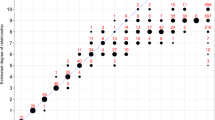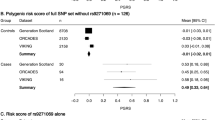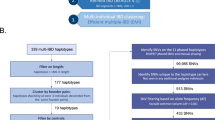Abstract
The neuregulin-1 gene (NRG1) at chromosome 8p21–22 has been implicated as a schizophrenia susceptibility gene in Icelandic, Scottish, Irish and mixed UK populations. The shared ancestry between these populations led us to investigate the NRG1 polymorphisms and appropriate marker haplotypes for linkage and/or association to schizophrenia in the Irish study of high-density schizophrenia families (ISHDSF). Neither single-point nor multi-point linkage analysis of NRG1 markers gave evidence for linkage independent of our pre-existing findings telomeric on 8p. Analysis of linkage disequilibrium (LD) across the 252 kb interval encompassing the 7 marker core Icelandic/Scottish NRG1 haplotype revealed two separate regions of modest LD, comprising markers SNP8NRG255133, SNP8NRG249130 and SNP8NRG243177 (telomeric) and microsatellites 478B14-428, 420M9-1395, D8S1810 and 420M9-116I12 (centromeric). From single marker analysis by TRANSMIT and FBAT we found no evidence for association with schizophrenia for any marker. Haplotype analysis for the three SNPs in LD region 1 and, separately, the four microsatellites in LD region 2 (analyzed in overlapping 2-marker windows), showed no evidence for overtransmission of specific haplotypes to affected individuals. We therefore conclude that if NRG1 does contain susceptibility alleles for schizophrenia, they impact quite weakly on risk in the ISHDSF.
This is a preview of subscription content, access via your institution
Access options
Subscribe to this journal
Receive 12 print issues and online access
$259.00 per year
only $21.58 per issue
Buy this article
- Purchase on Springer Link
- Instant access to full article PDF
Prices may be subject to local taxes which are calculated during checkout


Similar content being viewed by others
References
Riley B, Kendler KS . Schizophrenia: genetic epidemiology. In: Sadock BJ, Sadock VA (eds). Kaplan and Sadock's Comprehensive Textbook of Psychiatry, 8th edn. Lipincott, Williams and Wilkins: New York, in press.
Pulver AE, Lasseter VK, Kasch L, Wolyniec P, Nestadt G, Blouin JL et al. Schizophrenia: a genome scan targets chromosomes 3p and 8p as potential sites of susceptibility genes. Am J Med Genet 1995; 60: 252–260.
Blouin JL, Dombroski BA, Nath SK, Lasseter VK, Wolyniec PS, Nestadt G et al. Schizophrenia susceptibility loci on chromosomes 13q32 and 8p21. Nat Genet 1998; 20: 70–73.
Brzustowicz LM, Honer WG, Chow EW, Little D, Hogan J, Hodgkinson K et al. Linkage of familial schizophrenia to chromosome 13q32. Am J Hum Genet 1999; 65: 1096–1103.
Gurling HM, Kalsi G, Brynjolfson J, Sigmundsson T, Sherrington R, Mankoo BS et al. Genomewide genetic linkage analysis confirms the presence of susceptibility loci for schizophrenia, on chromosomes 1q32.2, 5q33.2, and 8p21–22 and provides support for linkage to schizophrenia, on chromosomes 11q23.3–24 and 20q12.1–11.23. Am J Hum Genet 2001; 68: 661–673.
Badner JA, Gershon ES . Meta-analysis of whole-genome linkage scans of bipolar disorder and schizophrenia. Mol Psychiatry 2002; 7: 405–411.
Webb BT, Wormley BR, Jiang Y, Straub RE, O'Neill FA, Walsh D et al. Linkage and association in the Irish study of high-density schizophrenia families indicate multiple schizophrenia susceptibility loci on chromosome 8. Neuropsychiatric Genet, in press.
Stefansson H, Sigurdsson E, Steinthorsdottir V, Bjornsdottir S, Sigmundsson T, Ghosh S et al. Neuregulin 1 and susceptibility to schizophrenia. Am J Hum Genet 2002; 71: 877–892.
Straub RE, MacLean CJ, Ma Y, Webb BT, Myakishev MV, Harris-Kerr C et al. Genome-wide scans of three independent sets of 90 Irish multiplex schizophrenia families and follow-up of selected regions in all families provides evidence for multiple susceptibility genes. Mol Psychiatry 2002; 7: 542–559.
Lewis CM, Levinson DF, Wise LH, DeLisi LE, Straub RE, Hovatta I et al. Genome scan meta-analysis of schizophrenia and bipolar disorder, Part II: Schizophrenia. Am J Hum Genet 2002; 73: 34–48.
Stefansson H, Sarginson J, Kong A, Yates P, Steinthorsdottir V, Gudfinnsson E et al. Association of neuregulin 1 with schizophrenia confirmed in a Scottish population. Am J Hum Genet 2003; 72: 83–87.
Williams NM, Preece A, Spurlock G, Norton N, Williams HJ, Zammit S et al. Support for genetic variation in neuregulin-1 and susceptibility to schizophrenia. Mol Psychiatry 2003; 8: 485–487.
Buonanno A, Fischbach GD . Neuregulin and ErbB receptor signaling pathways in the nervous system. Curr Opin Neurobiol 2001; 11: 28–96.
Corvin AP, Morris DW, McGhee K, Schwaiger S, Scully P, Quinn J et al. Confirmation and refinement of an ‘at-risk’ haplotype for schizophrenia suggests the EST cluster, Hs. 97632, as a potential susceptibility gene at the Neuregulin-1 locus. Mol Psychiatry 2004; 9: 208–213.
Kendler KS, MacLean CJ, O'Neill FA, Burke J, Murphy B, Duke F et al. Evidence for a schizophrenia vulnerability locus on chromosome 8p in the Irish study of high-density schizophrenia families. Am J Psychiatry 1996; 153: 1534–1540.
Cavalli-Sforza LL, Menozzi P, Piazza A . The History and Geography of Human Genes. Princeton University Press: New Jersey, 1994.
Straub RE, MacLean CJ, Ma Y, Webb BT, Myakishev MV, Harris-Kerr C et al. Genome-wide scans of three independent sets of 90 Irish multiplex schizophrenia families and follow-up of selected regions in all families provides evidence for multiple susceptibility genes. Mol Psychiatry 2002; 7: 542–559.
Reich DE, Cargill M, Bolk S, Ireland J, Sabeti PC, Richter DJ et al. Linkage diequilibrium in the human genome. Nature 2001; 411: 199–204.
Clayton D . A generalization of the transmission/disequilibrium test for uncertain-haplotype transmission. Am J Hum Genet 1999; 65: 1170–1177.
Rabinowitz D, Laird N . A unified approach to adjusting association tests for population admixture with arbitrary pedigree structure and arbitrary missing marker information. Hum Hered 2000; 50: 211–223.
Sobel E, Lange K . Descent graphs in pedigree analysis: applications to haplotyping, location scores, and marker sharing statistics. Am J Hum Genet 1996; 58: 1323–1337.
Van den Oord EJCG, Jiang Y, Riley BP, Kendler KS, Chen X . FP-TDI SNP genotype scoring by manual and statistical procedures: a study of error rates and types. Biotechniques 2003; 34: 610–624.
Weiss KM, Clark AG . Linkage disequilibrium and the mapping of complex human traits. Trends Genet 2002; 18: 19–24.
Purcell S, Cherny SS, Sham PC . Genetic power calculator: design of linkage and association genetic mapping studies of complex traits. Bioinformatics 2003; 19: 149–150.
Durner M, Greenberg DA, Hodge SE . Inter- and intrafamilial heterogeneity: effective sampling strategies and comparison of analysis methods. Am J Hum Genet 1992; 51: 859–870.
Kendler KS, O'Neill FA, Burke J, Murphy B, Duke F, Straub RE et al. Irish study on high-density schizophrenia families: field methods and power to detect linkage. Am J Med Genet 1996; 67: 179–190.
O'Connell JR, Weeks DE . PedCheck: a program for identification of genotype incompatibilities in linkage analysis. Am J Hum Genet 1998; 63: 259–266.
Abecasis GR, Cherny SS, Cookson WO, Cardon LR . Merlin—rapid analysis of dense genetic maps using sparse gene flow trees. Nat Genet 2002; 30: 97–101.
Abecasis GR, Cookson WO . GOLD—graphical overview of linkage disequilibrium. Bioinformatics 2000; 16: 182–183.
Acknowledgements
We acknowledge all families participating in this study. We also thank Michael Gill and coworkers for access to their NRG1 association data prior to publication.14 This work was supported by NIH Grants No. MH-41953 and MH-45390.
Author information
Authors and Affiliations
Corresponding author
Rights and permissions
About this article
Cite this article
Thiselton, D., Webb, B., Neale, B. et al. No evidence for linkage or association of neuregulin-1 (NRG1) with disease in the Irish study of high-density schizophrenia families (ISHDSF). Mol Psychiatry 9, 777–783 (2004). https://doi.org/10.1038/sj.mp.4001530
Received:
Revised:
Accepted:
Published:
Issue Date:
DOI: https://doi.org/10.1038/sj.mp.4001530
Keywords
This article is cited by
-
Personalized medicine in psychiatry: problems and promises
BMC Medicine (2013)
-
The association of white matter volume in psychotic disorders with genotypic variation in NRG1, MOG and CNP: a voxel-based analysis in affected individuals and their unaffected relatives
Translational Psychiatry (2012)
-
Measurement and comparison of serum neuregulin 1 immunoreactivity in control subjects and patients with schizophrenia: an influence of its genetic polymorphism
Journal of Neural Transmission (2010)
-
Neuregulin-1 genotypes and eye movements in schizophrenia
European Archives of Psychiatry and Clinical Neuroscience (2010)
-
Neuregulin 1 ICE-single nucleotide polymorphism in first episode schizophrenia correlates with cerebral activation in fronto-temporal areas
European Archives of Psychiatry and Clinical Neuroscience (2009)



